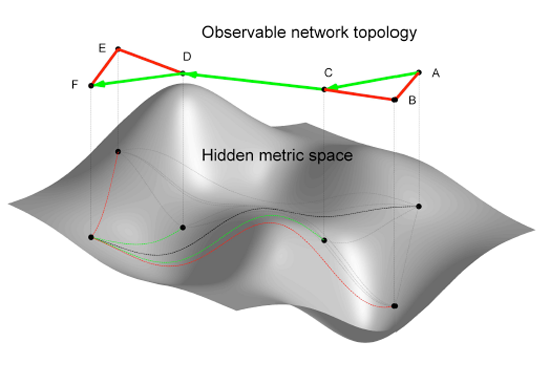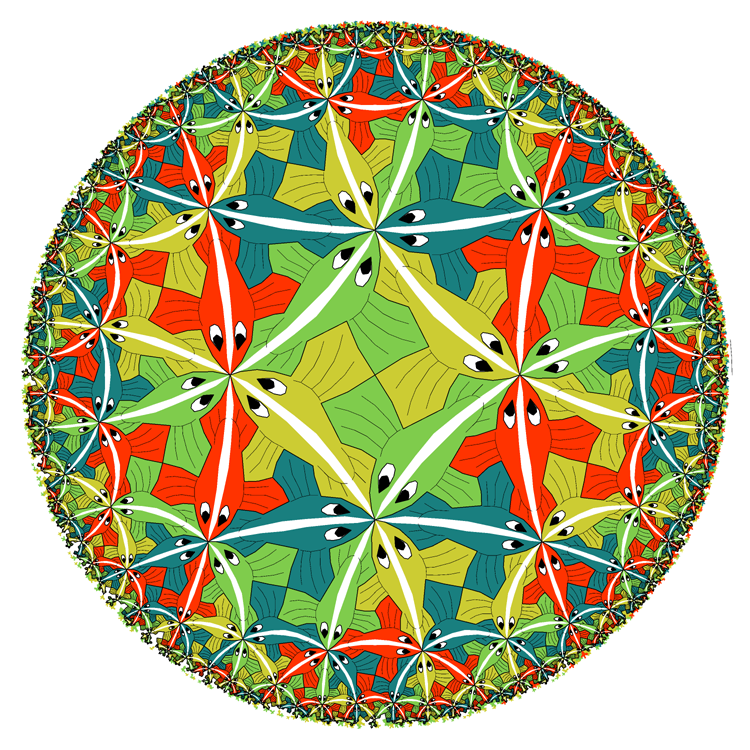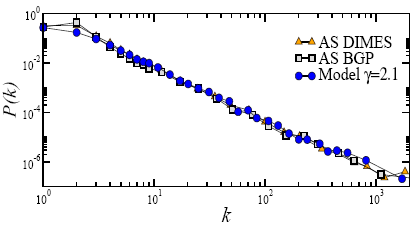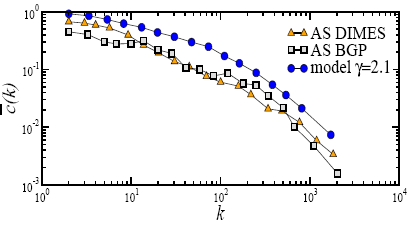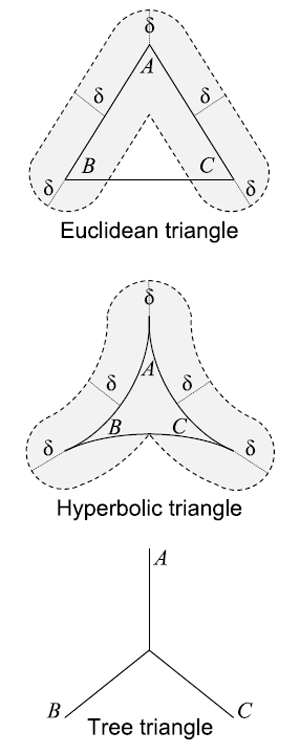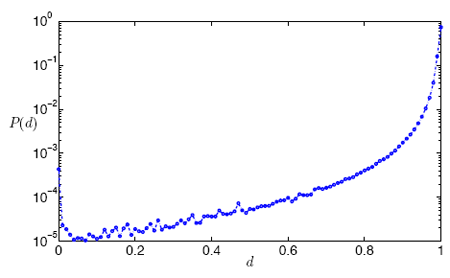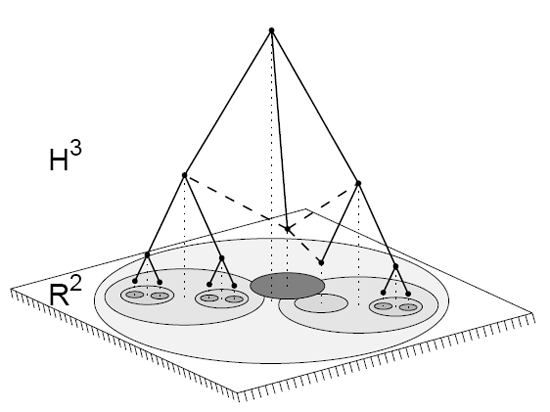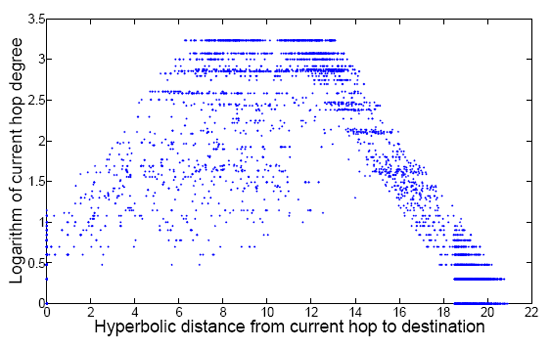Discovering Hyperbolic Metric Spaces Hidden Beneath the Internet and Other Complex Networks
An abbreviated version of the original proposal is shown below. For the longer version of the proposal for "NetSE: Discovering Hyperbolic Metric Spaces Hidden Beaneath the Internet and Other Complex Networks", please see the NetSE proposal in PDF.
Principal Investigators: Dmitri Krioukov kc claffy
Funding source: CNS-0964236 Period of performance: April 1, 2010 - March 31, 2014.
1 Introduction
The lack of predictive power over complex systems, either designed by humans or evolved by nature, is a foundational problem in contemporary science [2]. The Internet offers a paradigmatic example: nothing inherent in the design of the Internet architecture [3] can explain the Internet's peculiar complex1 large-scale structure [5], unexpectedly discovered decades after its inception. We are faced with an unsettling truth: the Internet topology has acquired emergent large-scale properties that are beyond our full understanding, much less control. The story is strikingly similar with the Web [6]. If the goal is to increase not only our understanding of complex networks, but also our ability to predict and engineer them, we believe the most promising direction is to study how this peculiar macroscopic structure relates to the function(s) of the network [4]. Our proposition is further strengthened by an astonishing fact: the peculiar structural characteristics of the Internet turn out to be eerily consistent with other complex networks found in nature, in particular with networks that exhibit naturally efficient, if not optimal, routing behavior without any global knowledge of network structure, e.g., neural and social networks [7,[8,[9]. This discovery poses a formidable intellectual challenge for network science and engineering. Conventional wisdom holds that finding communication paths to specific destinations through a network requires continually exchanging information about the status of connectivity between all nodes. The fundamentally unscalable overhead [10,[11] associated with this information exchange is built into our primary communication technologies today, including the Internet [12]. So we find it irresistibly interesting that so many other real networks in nature somehow "route traffic" efficiently without any global view of the system, i.e., nodes do not propagate any information about their connectivity status, but they efficiently find intended communication targets anyway. Our brains are a humbling example-to function they must successfully transmit specific signals to appropriate places in the body, but no neuron has a full view of global inter-neuron connectivity [7]. Milgram's experiments [8,[9] showed another classic demonstration of efficient routing without exchange of connectivity status information: humans can find paths to destinations through their social acquaintance network, even though no human has global knowledge of its structure. If man-made complex networks such as the Internet have a structure similar to so many networks in nature that can effectively route without global topology awareness, can network routing research take advantage of this efficiency? In our previous project [13], primarily motivated by Internet routing scalability problems, we focused on this question, and introduced a new theoretical framework to support its study. Our framework generalizes Kleinberg's seminal explanation [14,[15,[16,[17] of Milgram's experiments. In that explanation, a network consists of two types of links: local and long-range. The long-range links exist with some probability, which depends on the shortest path distance between nodes in the subgraph composed of local links. This subgraph is called the local graph. In our approach, we generalize the local graph to be a hidden metric space. We call our spaces hidden because they play the role of an underlying coordinate system not readily observable by examining the network topology. Instead they use internal attributes of individual nodes to impose some navigable shape onto the network. By metric we mean that for each pair of nodes there is a non-negative distance between them defined, satisfying the triangle inequality. Specifically, the distance between two nodes in the hidden space reflects similarity in their intrinsic attributes, functional or structural [18,[19,[20,[21,[22,[23]. Nodes closer in the hidden space, i.e., more similar, are connected in the network topology with higher probability. This generalization of Kleinberg's approach allows for more flexible and realistic models of similarity spaces underlying real networks. The described relationship between node similarity spaces and network topology also allows for a fundamentally different concept of routing. Without the overhead of maintaining topology knowledge, each node can forward information to its neighbor closest to the destination in the hidden space-a strategy known as greedy routing [14,[15,[16,[17], see Figure 1. Since this approach involves no traditional routing protocols or associated control plane, to be precise we will use the term greedy forwarding.2 describes our recent discoveries: not only do metric spaces underlie real complex network topologies including the Internet [24], but a greedy routing mechanism applied to such topologies yields a maximum percentage of successful [1]- and almost always shortest [25]-paths, regardless of the structure of the hidden space. This explanation for why (if not how) complex networks are naturally navigable had sufficiently high interdisciplinary impact for recent publication in Nature [1]. However, even though all successful greedy paths are shortest, and their percentage is maximized for real network topologies, not all paths are successful. Some paths never reach destinations, getting stuck at local minima-nodes that do not have any neighbors closer to the destination than themselves. The percentage of successful paths depends not only on the network structure, but also on the structure of the hidden space, and on the relationship between the two structures. We know that hidden spaces are metric, but we have not yet studied their most basic geometric property-curvature. Spaces fall into three categories depending on their curvature K: Euclidean (K=0), spherical (K > 0), or hyperbolic (K < 0). We hypothesize that the geometry of complex networks is negative, i.e., that their hidden metric spaces are hyperbolic. We propose exploring this hypothesis with three related tasks. First we will show analytically that the negative curvature of hidden hyperbolic geometries not only provides an explanation for the basic common structural properties of complex networks, but also optimizes an already efficient new approach to routing over such networks. Second, we will verify that hidden spaces underlying real networks are in fact negatively curved, and measure their basic geometric properties. Finally, our most challenging task will be to construct embeddings of the Internet and other complex networks into the identified hyperbolic spaces, such that greedy paths are shortest and successful even under dynamic network conditions. We outline our approach to these tasks in Section 3. If successful, this project will fundamentally impact network science and engineering. Distributed topology knowledge and, consequently, routing updates would be unnecessary. Routing table sizes could be reduced to their theoretical minimum since instead of keeping a routing table entry for each destination in the network, nodes would be able to transmit information using only hidden space coordinates of their neighbors. We will have solved the two most fundamental routing scaling limitation of networks such as the Internet [12], and in the process created an essentially infinitely scalable routing architecture. But our target of study is one of the most fundamental mysteries of all complex networks. The range of potential interdisciplinary applications (see Section 4) includes not only the Internet, but also recommender systems, search engines, terrorist network modeling, cancer and brain research, protein folding, and drug design. Increasing predictive power over complex systems is our long-term objective. But we do not yet fully comprehend what laws govern the evolutionary dynamics of complex networks; we have only begun to identify their peculiar structure. If their structure is a result of natural evolution, we are interested in how this structure relates to their primary functions-are networks in nature optimizing toward information signaling (routing) efficiency? Discovery of the hidden metric spaces responsible for the primary function of many complex networks, i.e., communication without global knowledge, is the logical next step in our research agenda.
2 Previous work
|
3 Proposed work
Our three tasks, shown in Figure 2, involve analytic proofs, measurement and data analysis, and model construction and validation. Task 1 is to gain mathematical knowledge of how specific geometric properties of hyperbolic spaces are manifested in observed networks. Completion of Task 1 will allow us to explore node similarity spaces underlying real networks, verify that they are hyperbolic, and measure their geometric properties, such as curvature (Task 2). Knowledge of what spaces to look for (obtained from Task 2) will lead to our ultimate goal-embedding of real networks into the identified hyperbolic spaces, such that greedy paths are shortest and successful even under dynamic network conditions. Before we describe these tasks in detail, we motivate our central hypothesis that hidden spaces are hyperbolic. Motivation for hyperbolic HMSs. The intuitive explanation for the power of hyperbolic geometry to abstract node similarity spaces lies in the observation that complex networks are systems of connections between heterogeneous nodes. Heterogeneity implies that in reality nodes can be classified into groups, subgroups, subsubgroups, and so on. This taxonomy of nodes naturally results in a tree-like structure akin to a library catalog, in which the distance between two nodes estimates how similar they are [18,[23]. Such tree-like structures are known to be hyperbolic, i.e., negatively curved [26]. The node classification hierarchy need not be strictly a tree. Approximate "tree-ness" is sufficient for hyperbolic representation [26]. Mathematically, the last statement is rooted in the main property of hyperbolic geometry-exponential expansion of space [27]. Figure 3 illustrates the Poincaré disc model [28] of the hyperbolic plane, which is the two-dimensional space of constant curvature K=-1. The area of a disc of hyperbolic radius R grows as eR in the hyperbolic plane [28]. But trees possess essentially the same metric structure as the hyperbolic plane. In a b-ary tree, i.e., a tree with branching factor b, the volume of a ball of radius R, measured as the number of nodes lying within R hops from the root, grows as bR. From the purely metric perspective, the hyperbolic plane is thus equivalent to a tree with the average branching factor equal to e. Informally, hyperbolic spaces can be thought of as "continuous versions" of trees. This metric equivalence between hyperbolic spaces and tree-like structures, which naturally abstract taxonomy-based similarities among heterogeneous nodes, explains why hyperbolic geometry is a promising model for HMSs underlying complex networks.3.1 Task 1: Prove analytically that hyperbolic geometries are the most congruent with complex network topologies
|
|
3.2 Task 2: Measure geometric properties of hyperbolic spaces hidden under real networks
In Task 1 we start with a continuous hyperbolic space, and then distribute nodes in it to build a synthetic network. The hidden distances between these nodes form a finite metric space. In Task 2, we explore the reverse problem: starting with the finite metric space formed by the similarity distances between nodes in a real network, we infer the properties of a corresponding underlying continuous space, verify that it is hyperbolic, and then relate its geometric properties to the network's topological properties, using the mathematical apparatus developed in Task 1.
|
|
3.3 Task 3: Construct embeddings of real networks into the identified hyperbolic spaces requiring no global knowledge of network topologies
|
|
4 Interdisciplinary aspects and potential applications
Although our original motivation for embedding complex networks in geometric spaces was to design scalable routing for the Internet, this project will expand the utility of our theoretical framework to a broad range of interdisciplinary applications in network science and engineering beyond the proposed scope of work. Searching and navigation strategies. The most direct application of navigation is search. Searching for specific nodes is a task that arises in many networks. One can search for specific individuals, e.g., terrorists [72,[73,[74], in traditional or on-line social networks (cf. Milgram's experiments [8,[9]), for specific content on the Web or overlay/P2P networks, for specific knowledge in Wikipedia or paper citation networks. Discovery of the HMSs underlying these systems can improve the quality of existing search engines, and lead to designing future ones. Recommender systems. Recommender systems [75,[76] are closely related to search. To recommend a product that a user might like, they estimate similarities among users, e.g., among book buyers at Amazon or DVD renters at Netflix. These systems assume that similar users tend to like similar products or content. Often these similarity spaces are embedded in Euclidean spaces to enable navigation [77]. Finding more congruent hyperbolic embeddings for these similarity spaces could significantly improve the quality of such recommender systems and the efficiency of navigation (browsing). Discovery of missing and false links. Topology measurements of many real networks, not only of the Internet [78,[79,[80,[81], miss some links, and contain some false ones [82,[83,[84,[85,[86]. Missing links can be a critical problem, for example in networks of terrorist or protein interactions [84,[85,[86]. Knowledge of the HMS and connection probability for a network helps to predict missing and false links [23]. Systems biology: cancer and brain research. A great deal of cancer research studies signaling pathways in the gene regulatory networks [87,[88,[89]. The main process in the brain is also signal propagation [7,[90,[91]. Propagation of cellular and neural information are two paradigmatic examples of navigation without global knowledge. Understanding how HMSs effectively guide these navigation processes, including which functional network components correspond to specific neighborhoods in the HMS, can significantly advance studies of cancer and the brain. Cognitive science: memory and consciousness. Natural language is a translation of semantic concepts in the brain into external lexical representations. Cognitive science studies what sources of statistical information are relevant in psycholinguistic processes. This research has introduced semantic space models to formalize the cognitive processes we use to organize, store and retrieve information [92,[93,[94,[95,[96]. The semantic similarity between two words is the cosine similarity of the vectors representing these words in the semantic space. Finding accurate representations of these underlying spaces can contribute to research on cognitive processes as emergent complex phenomena. Protein folding and drug design. At a workshop [97] organized for our previous project [13], we learned an unexpected application of greedy forwarding over an HMS-protein folding [98,[99], a critical component in the design of new drugs [100]. In this case, the HMS is a protein conformation free energy profile, nodes are protein conformations, and two conformations are connected if they can be obtained from each other by one amino-acid rotation. Protein folding is then equivalent to greedy forwarding toward the minimum-energy conformation [99]. The discovery of a protein folding HMS is thus equivalent to the description of its energy profile. Wireless and social networking. Our HMS framework applied as is to traditional wireless networking becomes well-known geographic routing [54,[55,[56,[57,[58]. But the underlying geographic space is neither hidden nor hyperbolic, distances in it do not reflect any node similarities, and wireless network topologies do not resemble complex network topologies [101]. Most importantly, there is no congruency between node flat ID addressing and the underlying geography, unless nodes dynamically learn and redistribute the information about their positions, which for large networks involves exactly the enormous communication overhead that prevents scaling. Therefore the applicability of HMSs, especially hyperbolic ones, to traditional wireless networking is not obvious. Nevertheless, we believe our framework can be useful for emerging models of wireless networks, in which the "social overlay" guides forwarding [102,[103,[104,[105,[106]. In these models, the destination of information propagation is a specific individual or content. Forwarding decisions rely on social distances to the destination, while network connectivity is provided by the highly dynamic "wireless underlay." The HMSs in this case are social distance spaces, which we hypothesize (and explore in Task 2) are hyperbolic.5 Broader impacts
Complex networks are ubiquitous in all domains of science and engineering, and permeate many aspects of daily human life, from biological to social, economic, transportation, and communication [107]. Our growing dependence on networks has inspired a burst of activity in the new field of network science [2], keeping researchers motivated to solve the difficult challenges that networks offer. Among these, the relation between network structure and function is perhaps the most important and fundamental [4]. Transport is one of the most common functions of networked systems. Examples span many domains: transport of energy in metabolic networks, of mass in food webs, of wealth, funds, and products in economic networks, of people in transportation systems, or of information in cell signaling processes and, of course, across the Internet. Although our motivating focus is information transport in the Internet, we are aiming directly at the most fundamental mysteries of complex networks. Therefore our results may have broad and lasting impact on many sciences and disciplines. Our work will also cross-fertilize networking, theoretical computer science, physics, and mathematics, as our approach relies on tools and techniques from all these disciplines. Our agenda is thus directly responsive to the need for interdisciplinary advances articulated by NSF in this program solicitation. In addition to publishing our results via conferences, journals, and on the web, we will present to network engineering groups (IETF, IRTF), as well as in academic research venues and visits. PI Krioukov presented results at several universities worldwide in 2008 [108], finding several students interested in the proposed work. We will host an interdisciplinary workshop during this project, building on the success of related previous workshops [109,[97], with new focus on the boundaries and relationships among science, engineering, economics, and policy constraints. PI Krioukov is an editorial board member of the ACM SIGCOMM Computer Communication Review. He has served as a PC member at SIGCOMMs, CoNext, NetSciCom, SIMPLEX, and other venues, and regularly reviews for IEEE/ACM Transactions on Networking. PI Claffy is on the program committee for PAM 2009, Internet2's Research Advisory Council, and ICANN's Security and Stability Committee. UC Boguñá reviews for Physical Review Letters, Physical Review E, Journal of Statistical Physics, among others. In 2008 he received the Outstanding Referee Award [110] from the American Physical Society. UC Serrano is also a regular referee for many of the top physics journals. In 2009 she won a prestigious Ramón y Cajal award from the Spanish Ministry of Science, and is developing a research agenda in Systems Biology, which will strengthen the interdisciplinary aspects and potential applications of this project. The project improves the presence of under-represented groups in science. Two senior members on this proposal (PI Claffy and UC Serrano) are females. PI Krioukov co-advised female PhD students Priya Mahadevan and Almerima Jamakovic who successfully moved to HP Labs and TNO after their graduation. PIs Claffy and Krioukov regularly work with an NSF-sponsored Research Experiences for Undergraduates (REU) program to mentor under-represented undergraduates from UCSD and other universities, giving students invaluable early experience in Internet research.References
- [1]
- M. Boguñá, D. Krioukov, and kc claffy, "Navigability of complex networks," Nature Physics, vol. 5, pp. 74-80, 2009.
- [2]
- C. B. Duke, ed., Network Science. Washington: The National Academies Press, 2006.
- [3]
- D. Clark, "The design philosophy of the DARPA Internet protocols," in SIGCOMM, 1988.
- [4]
- M. E. J. Newman, "The structure and function of complex networks," SIAM Rev, vol. 45, no. 2, pp. 167-256, 2003.
- [5]
- M. Faloutsos, P. Faloutsos, and C. Faloutsos, "On power-law relationships of the Internet topology," in SIGCOMM, 1999.
- [6]
- J. Hendler, N. Shadbolt, W. Hall, T. Berners-Lee, and D. Weitzner, "Web science: An interdisciplinary approach to understanding the Web," Commun ACM, vol. 51, no. 7, pp. 60-69, 2008.
- [7]
- P. Churchland and T. J. Sejnowski, The Computational Brain. Boston: The MIT Press, 1994.
- [8]
- S. Milgram, "The small world problem," Psychol Today, vol. 1, pp. 61-67, 1967.
- [9]
- J. Travers and S. Milgram, "An experimental study of the small world problem," Sociometry, vol. 32, pp. 425-443, 1969.
- [10]
- A. Korman and D. Peleg, "Dynamic routing schemes for general graphs," in ICALP, 2006.
- [11]
- D. Krioukov, kc claffy, K. Fall, and A. Brady, "On compact routing for the Internet," Comput Commun Rev, vol. 37, no. 3, pp. 41-52, 2007.
- [12]
- D. Meyer, L. Zhang, and K. Fall, "Report from the IAB workshop on routing and addressing." IETF, RFC 4984, 2007.
- [13]
- CAIDA, "NeTS-FIND: Greedy routing on hidden metric spaces as a foundation of scalable routing architectures without topology updates." Research Project. https://www.caida.org/funding/nets-find/.
- [14]
- J. Kleinberg, "Navigation in a small world," Nature, vol. 406, p. 845, 2000.
- [15]
- J. Kleinberg, "The small-world phenomenon: An algorithmic perspective," in STOC, 2000.
- [16]
- J. Kleinberg, "Small-world phenomena and the dynamics of information," in NIPS, 2001.
- [17]
- J. Kleinberg, "Complex networks and decentralized search algorithms," in ICM, 2006.
- [18]
- D. J. Watts, P. S. Dodds, and M. E. J. Newman, "Identity and search in social networks," Science, vol. 296, pp. 1302-1305, 2002.
- [19]
- M. Girvan and M. E. J. Newman, "Community structure in social and biological networks," Proc Natl Acad Sci USA, vol. 99, pp. 7821-7826, 2002.
- [20]
- F. Menczer, "Growing and navigating the small world Web by local content," Proc Natl Acad Sci USA, vol. 99, pp. 14014-14019, 2002.
- [21]
- E. A. Leicht, P. Holme, and M. E. J. Newman, "Vertex similarity in networks," Phys Rev E, vol. 73, p. 026120, 2006.
- [22]
- D. Crandall, D. Cosley, D. Huttenlocher, J. Kleinberg, and S. Suri, "Feedback effects between similarity and social influence in online communities," in KDD, 2008.
- [23]
- A. Clauset, C. Moore, and M. E. J. Newman, "Hierarchical structure and the prediction of missing links in networks," Nature, vol. 453, pp. 98-101, 2008.
- [24]
- M. Á. Serrano, D. Krioukov, and M. Boguñá, "Self-similarity of complex networks and hidden metric spaces," Phys Rev Lett, vol. 100, p. 078701, 2008.
- [25]
- M. Boguñá and D. Krioukov, "Navigating ultrasmall worlds in ultrashort time," Phys Rev Lett, vol. 102, p. 058701, 2009.
- [26]
- M. Gromov, Metric Structures for Riemannian and Non-Riemannian Spaces. Boston: Birkhäuser, 2007.
- [27]
- D. Burago, Y. Burago, and S. Ivanov, A Course in Metric Geometry. Providence: AMS, 2001.
- [28]
- J. W. Anderson, Hyperbolic Geometry. London: Springer-Verlag, 2005.
- [29]
- J. Cannon, W. Floyd, R. Kenyon, and W. Parry, Flavors of Geometry, ch. Hyperbolic Geometry. Berkeley: MSRI, 1997.
- [30]
- M. R. Bridson and A. Haefliger, Metric Spaces of Non-Positive Curvature. Berlin: Springer-Verlag, 1999.
- [31]
- P. Mahadevan, D. Krioukov, K. Fall, and A. Vahdat, "Systematic topology analysis and generation using degree correlations," in SIGCOMM, 2006.
- [32]
- "University of Oregon RouteViews Project." http://www.routeviews.org/.
- [33]
- "The DIMES project." https://en.wikipedia.org/wiki/DIMES.
- [34]
- C. Manning, P. Raghavan, and H. Schütze, Introduction to Information Retrieval. Cambridge: Cambridge University Press, 2008.
- [35]
- X. Dimitropoulos, D. Krioukov, G. Riley, and kc claffy, "Revealing the Autonomous System taxonomy: The machine learning approach," in PAM, 2006.
- [36]
- L. Gao, "On inferring Autonomous System relationships in the Internet," IEEE ACM T Network, vol. 9, no. 6, 2001.
- [37]
- L. Subramanian, S. Agarwal, J. Rexford, and R. H. Katz, "Characterizing the Internet hierarchy from multiple vantage points," in INFOCOM, 2002.
- [38]
- X. Dimitropoulos, D. Krioukov, M. Fomenkov, B. Huffaker, Y. Hyun, kc claffy, and G. Riley, "AS relationships: Inference and validation," Comput Commun Rev, vol. 37, no. 1, 2007.
- [39]
- D. Michel-Marie and E. Deza, Dictionary of Distances. Amsterdam: Elsevier, 2006.
- [40]
- A. Clauset, M. E. J. Newman, and C. Moore, "Finding community structure in very large networks," Phys Rev E, vol. 70, p. 066111, 2004.
- [41]
- L. Danon, J. Duch, A. Arenas, and A. Díaz-Guilera, Large Scale Structure and Dynamics of Complex Networks: From Information Technology to Finance and Natural Science, ch. Community Structure Identification. Singapore: World Scientific, 2007.
- [42]
- M. Boguñá, R. Pastor-Satorras, A. Díaz-Guilera, and A. Arenas, "Models of social networks based on social distance attachment," Phys Rev E, vol. 70, p. 056122, 2004.
- [43]
- S. Novikov and I. Taimanov, Modern Geometric Structures and Fields. Providence: AMS, 2006.
- [44]
- M. Gromov, "Hyperbolic groups," in Essays in Group Theory, vol. 8 of Math Sci Res Inst Publ, pp. 75-263, New York: Springer, 1987.
- [45]
- "Wikipedia." http://www.wikipedia.org/.
- [46]
- R. Krauthgamer and J. R. Lee, "Algorithms on negatively curved spaces," in FOCS, 2006.
- [47]
- I. Abraham, M. Balakrishnan, F. Kuhn, D. Malkhi, V. Ramasubramanian, and K. Talwar, "Reconstructing approximate tree metrics," in PODC, 2007.
- [48]
- E. Jonckheere, P. Lohsoonthorn, and F. Bonahon, "Scaled Gromov hyperbolic graphs," J. Graph Theory, vol. 57, no. 2, 2008.
- [49]
- R. Kleinberg, "Geographic routing using hyperbolic space," in INFOCOM, 2007.
- [50]
- H. Chang, S. Jamin, and W. Willinger, "To peer or not to peer: Modeling the evolution of the Internet's AS-level topology," in INFOCOM, 2006.
- [51]
- P. Holme, J. Karlin, and S. Forrest, "An integrated model of traffic, geography and economy in the Internet," Comput Commun Rev, vol. 38, no. 3, 2008.
- [52]
- Digital Envoy, "Netacuity." http://www.digital-element.net/ip_intelligence/ip_intelligence.html.
- [53]
- A. Okabe, B. Boots, K. Sugihara, and S. N. Chiu, Spatial Tessellations: Concepts and Applications of Voronoi Diagrams. London: Wiley-Interscience, 2000.
- [54]
- B. Karp and H. T. Kung, "Greedy perimeter stateless routing for wireless networks," in MobiCom, 2000.
- [55]
- A. Rao, S. Ratnasamy, C. Papadimitriou, S. Shenker, and I. Stoica, "Geographic routing without location information," in MobiCom, 2003.
- [56]
- R. Gummadi, R. Govindan, N. Kothari, B. Karp, Y.-J. Kim, and S. Shenker, "Reduced state routing in the Internet," in HotNets, 2004.
- [57]
- Y.-J. Kim, R. Govindan, B. Karp, and S. Shenker, "Geographic routing made practical," in NSDI, 2005.
- [58]
- F. Kuhn, R. Wattenhofer, and A. Zollinger, "An algorithmic approach to geographic routing in ad hoc and sensor networks," IEEE ACM T Network, vol. 16, no. 1, 2008.
- [59]
- M. Motiwala, M. Elmore, N. Feamster, and S. Vempala, "Path splicing," in SIGCOMM, 2008.
- [60]
- C. Gkantsidis, M. Mihail, and A. Saberi, "Conductance and congestion in power law graphs," in SIGMETRICS, 2003.
- [61]
- O. Cappé, E. Moulines, and T. Rydén, Inference in Hidden Markov Models. New York: Springer, 2007.
- [62]
- E. Lebhar and N. Schabanel, "Almost optimal decentralized routing in long-range contact networks," in ICALP, 2004.
- [63]
- G. Manku, M. Naor, and U. Wieder, "Know thy neighbor's neighbor: The power of lookahead in randomized P2P networks," in STOC, 2004.
- [64]
- C. Martel and V. Nguyen, "Analyzing Kleinberg's (and other) small-world models," in PODC, 2004.
- [65]
- P. Fraigniaud, C. Gavoille, and C. Paul, "Eclecticism shrinks even small worlds," Distrib Comput, vol. 18, no. 4, pp. 279-291, 2006.
- [66]
- L. A. Adamic, R. M. Lukose, A. R. Puniyani, and B. A. Huberman, "Search in power-law networks," Phys Rev E, vol. 64, p. 46135, 2001.
- [67]
- L. A. Adamic and E. Adar, "How to search a social network," Social Networks, vol. 27, no. 3, pp. 187-203, 2005.
- [68]
- A. Korman and S. Kutten, "Labeling schemes with queries." arXiv:cs.DC/0609163.
- [69]
- J. M. Guiot, "A modification of Milgram's small world method," Eur J of Soc Psychol, vol. 6, pp. 503-507, 1976.
- [70]
- A. Dhamdhere and K. Dovrolis, "Ten years in the evolution of the Internet ecosystem," in IMC, 2008.
- [71]
- CAIDA, "Visualizing Internet topology at a macroscopic scale." https://www.caida.org/projects/as-core/.
- [72]
- J. Xu and H. Chen, "The topology of dark networks," Commun ACM, vol. 51, no. 10, pp. 58-65, 2008.
- [73]
- J. Allanach, H. Tu, S. Singh, P. Willett, and K. Pattipati, "Detecting, tracking, and counteracting terrorist networks via hidden Markov models," in IEEE Aerospace Conf, 2004.
- [74]
- A. Gutfraind, "Understanding terrorist organizations with a dynamical model," Stud Confl Terror, vol. 31, no. 12, 2008.
- [75]
- D. Monroe, "Just for you," Commun ACM, vol. 52, no. 8, pp. 15-17, 2009.
- [76]
- G. Uchyigit and M. Y. Ma, Personalization Techniques and Recommender Systems. Singapore: World Scientific, 2008.
- [77]
- O. Goussevskaia, M. Kuhn, M. Lorenzi, and R. Wattenhofer, "From Web to map: Exploring the world of music," in WI, 2008.
- [78]
- A. Lakhina, J. Byers, M. Crovella, and P. Xie, "Sampling biases in IP topology measurements," in INFOCOM, 2003.
- [79]
- D. Achlioptas, A. Clauset, D. Kempe, and C. Moore, "On the bias of traceroute sampling," in STOC, 2005.
- [80]
- A. Clauset and C. Moore, "Accuracy and scaling phenomena in Internet mapping," Phys Rev Lett, vol. 94, p. 018701, 2005.
- [81]
- L. Dall'Asta, I. Alvarez-Hamelin, A. Barrat, A. Vázquez, and A. Vespignani, "Exploring networks with traceroute-like probes: Theory and simulations," Theor Comput Sci, Complex Networks, vol. 355, no. 1, pp. 6-24, 2006.
- [82]
- N. D. Martinez, B. A. Hawkins, H. A. Dawah, and B. P. Feifarek, "Effects of sampling effort on characterization of food-web structure," Ecology, vol. 80, pp. 1044-1055, 1999.
- [83]
- J. A. Dunne, R. J. Williams, and N. D. Martinez, "Food-web structure and network theory: The role of connectance and size," Proc Natl Acad Sci USA, vol. 99, pp. 12917-12922, 2002.
- [84]
- T. Ito, T. Chiba, R. Ozawa, M. Yoshida, M. Hattori, and Y. Sakaki, "A comprehensive two-hybrid analysis to explore the yeast protein interactome," Proc Natl Acad Sci USA, vol. 98, pp. 4569-4574, 2001.
- [85]
- E. Sprinzak, S. Sattath, and H. Margalit, "How reliable are experimental protein-protein interaction data?," J Mol Biol, vol. 327, pp. 919-923, 2003.
- [86]
- A. Szilágyi, V. Grimm, A. K. Arakaki, and J. Skolnick, "Prediction of physical protein-protein interactions," Phys Biol, vol. 2, pp. S1-S16, 2005.
- [87]
- J. S. Gutkind (Edt.), Signaling Networks and Cell Cycle Control: The Molecular Basis of Cancer and Other Diseases (Cancer Drug Discovery and Development). New York: Humana Press, 2000.
- [88]
- B. Groner (Edt.), Targeted Interference with Signal Transduction Events (Recent Results in Cancer Research). Berlin: Springer-Verlag, 2007.
- [89]
- G. Finocchiaro, F. M. Mancuso, D. Cittaro, and H. Muller, "Graph-based identification of cancer signaling pathways from published gene expression signatures using PubLiME," Nucleic Acids Res, vol. 35, no. 7, pp. 2343-2355, 2007.
- [90]
- P. Dayan and L. F. Abbott, Theoretical Neuroscience: Computational and Mathematical Modeling of Neural Systems. Boston: The MIT Press, 2005.
- [91]
- J. G. Nicholls, A. R. Martin, B. G. Wallace, and P. A. Fuchs, From Neuron to Brain: A Cellular and Molecular Approach to the Function of the Nervous System. Boston: Sinauer Associates, 2001.
- [92]
- C. E. Osgood, "Exploration in semantic space: A personal diary," J Soc Issues, vol. 27, pp. 5-64, 1971.
- [93]
- K. Lund and C. Burgess, "Producing high-dimensional semantic spaces from lexical co-occurrence," Behav Res Meth Ins C, vol. 28, pp. 203-208, 1996.
- [94]
- T. K. Landauer and S. T. Dumais, "A solution to Plato's problem: The latent semantic analysis theory of acquisition, induction, and representation of knowledge," Psychol Rev, vol. 104, pp. 211-240, 1997.
- [95]
- M. N. Jones and D. J. K. Mewhort, "Representing word meaning and order information in a composite holographic lexicon," Psychol Rev, vol. 114, no. 1, pp. 1-37, 2007.
- [96]
- B. T. Johns and M. N. Jones, "Predicting word-naming and lexical decision times from a semantic space model," in CogSci, 2008.
- [97]
- SFI and CAIDA, "Workshop on Networks and Navigation," 2008. https://www.caida.org/workshops/sfi/0808/.
- [98]
- F. Rao and A. Caflisch, "The protein folding network," J Mol Biol, vol. 342, pp. 299-306, 2004.
- [99]
- E. Ravasz, S. Gnanakaran, and Z. Toroczkai, "Network structure of protein folding pathways," 2007. arXiv:0705.0912.
- [100]
- R. Broglia, L. Serrano, and G. Tiana (Edts.), Protein Folding and Drug Design. Amsterdam: IOS Press, 2007.
- [101]
- M. Franceschetti and R. Meester, Random Networks for Communication: From Statistical Physics to Information Systems. Cambridge: Cambridge University Press, 2008.
- [102]
- E. M. Daly and M. Haahr, "Social network analysis for routing in disconnected delay-tolerant MANETs," in MobiHoc, 2007.
- [103]
- A. Miklas, K. Gollu, K. Chan, S. Saroiu, K. Gummadi, and E. de Lara, "Exploiting social interactions in mobile systems," in UbiComp, 2007.
- [104]
- P. Hui, J. Crowcroft, and E. Yoneki, "BUBBLE rap: Social-based forwarding in delay tolerant networks," in MobiHoc, 2008.
- [105]
- A. Mtibaa, A. Chaintreau, J. LeBrun, E. Oliver, A.-K. Pietilainen, and C. Diot, "Are you moved by your social network application?," in WOSN, 2008.
- [106]
- A. Chaintreau, P. Fraigniaud, and E. Lebhar, "Opportunistic spatial gossip over mobile social networks," in WOSN, 2008.
- [107]
- M. Castells, The Rise of the Network Society (The Information Age: Economy, Society and Culture). Oxford: Blackwell Publishing, 2000.
- [108]
- https://catalog.caida.org/presentation/2008_krioukov_euvarious.
- [109]
- CAIDA, "Workshop on the Internet Topology," 2006. https://www.caida.org/workshops/isma/0605/.
- [110]
- American Physical Society, "Outstanding referees." http://publish.aps.org/OutstandingReferees.
Footnotes:
1We use the term complex network topology to denote topologies with two basic structural properties: strong clustering, i.e., large numbers of 3-cycles, and heavy-tailed distributions of node degrees, i.e., distributions with diverging second moments, which sometimes approximately follow power laws [4]. Notably, wireless networks do not have these properties, see Section 4.File translated from TEX by T T H, version 3.72.
On 13 Apr 2010, 11:35.



